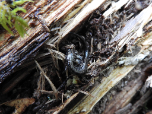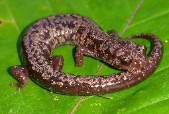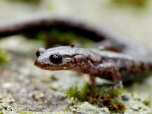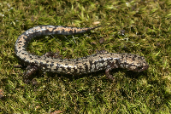Weller's Salamander (Plethodon welleri)
Description: Weller's salamander has 16 coastal or costal grooves with light dorsal markings. The markings are usually dark gold in color with a metallic sheen. These are smaller salamanders, like most plethodontids, and have a slender body. They have 17 trunk vertebrae, which makes them the shortest of the eastern small plethodontids, and two to seven vomerin teeth that are located in series. These salamanders also have webbed toes. Males and females have differing visible genitalia for sex differentiation. Females have a simple slit, while males have a cloacal gland and papillae in the vent.
Habitat: They inhabit spruce and birch forests that are heavily shaded. Some individuals were found in upper-level hardwood forests. The salamanders prefer habitats with cooler temperatures. These salamanders are generally found under logs, stones, and flat rocks in their preferred habitats.
Range: This species of plethodon salamander is a high-altitude species found in the southern Blue Ridge Mountains. Their range includes northwest North Carolina and portions of Tennessee and Virginia into which the mountains extend. However, these salamanders are restricted to a few counties in the mentioned states. The counties include Johnson and Unicoi Counties in Tennessee and Yancey County in North Carolina.
Found in these States:
NC |
TN |
VA
Diet: They are insectivores that feed on insects, including pseudoscorpions, orb-weaver spiders, ticks and mites, springtails, true bugs, butterflies and moths, flies, and beetles.
Reproduction: Weller's salamanders breed during the spring and fall. Courtship behaviors have been observed in captivity in October and April. The females are reproductively mature at 35 mm in length and tend to be older than 3 years when they become mature. The males can breed around 30 mm long at about 2 to 3 years old. The females lay eggs in clutches of four to 11 eggs in tight clusters suspended by a stalk. These nests are found under the moss mats that cover conifer logs. The eggs are seen between mid-August to September and are between 2.6 and 6.5 mm in diameter. The offspring show direct development with little to no evidence of gills being visible once the egg has hatched. Some evidence indicates the females brood or guard the eggs. The females found at these nests were undernourished, which indicates they do not feed during their time guarding the eggs. The eggs laid by the females are dark in color due to pigmentation by melanophores.
Status: Listed as Vulnerable because its extent of occurrence (EOO) is 6,120 km2, it occurs in ten or fewer threat-defined locations, and there is continuing decline in the extent and quality of its habitat.
»» Kingdom: Animalia - Animals
»» Phylum: Chordata - Chordates
»» Subphylum: Vertebrata - Vertebrates
»» Class: Amphibia - (Amphibians)
»» Order: Caudata - Salamanders
»» Family: Plethodontidae - Lungless Salamanders
»» Genus: Plethodon
»» Species: Plethodon welleri - Weller's Salamander
This article uses material from the Wikipedia article "Weller's Salamander", which is released under the Creative Commons Attribution-Share-Alike License 3.0. Content may have been omitted from the original, but no content has been changed or extended.
|













